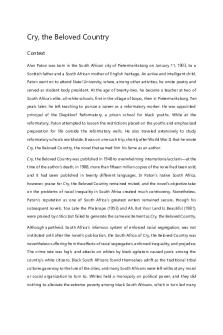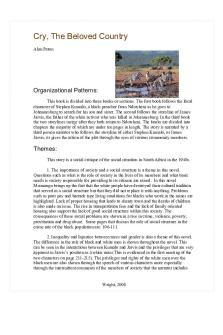The Cry of the Children - Grade: A+ PDF

| Title | The Cry of the Children - Grade: A+ |
|---|---|
| Course | British Literature II |
| Institution | University of Louisiana at Lafayette |
| Pages | 5 |
| File Size | 63.4 KB |
| File Type | |
| Total Downloads | 1 |
| Total Views | 169 |
Summary
This essay discusses how Elizabeth Barrett Browning's "The Cry of the Children" is used as a political piece to express the horrors of child labor during the time it was written. ...
Description
Holmes 1 Kristen Holmes Mr. Calhoun English 202: British Literature II 10 October 2016 "The Cry of the Children" Elizabeth Barrett Browning uses "The Cry of the Children" as a political piece. Through the use of imagery and disillusionment, Browning has created a vessel to express the truth about child labor. This complex work allows the reader to relate to a child's situation and feel for the child. "The Cry of the Children" is a plea, it is a plea for help by someone who is observing these horrible situations. The thoughts, desires, and wishes of the children are descried thoroughly throughout the poem, justifying the need for change. The conditions that each child experiences each day brings tears to the eyes of those children, and they cry. An inconsolable cry that even the comfort of their mothers cannot stop. Mothers are known to make every son or daughters worries go away. Their consolation puts to rest any uneasiness and makes everything better again. However, these children continue to cry even while in the embrace of their mothers. Browning uses this image of an inconsolable child to establish the harshness of the conditions that they must work in. The author continues, stating that even young lambs, birds, fawns, and flowers are able to enjoy themselves the way that they should. Meanwhile, our own youth are restless and suffering. While these children weep, others who do not hear them continue on with their day to day lives, happy, unconcerned with the ones being taken advantage of. Browning addresses the neglect of the children from the owners that
Holmes 2 have forced them to perform this harsh labor. She wants them to understand the severity of the situations that these influential people are causing. The world that these children know is not one of freedom, it is cold and cruel. The world that these children live in is so cruel that they would rather die than continue living how they are living now. Through the death of young Alice, Browning implants the image of the child's death in the mind of the reader. Emphasizing the harshness of the environment in which the children work, as well as the lack of concern of the employer for the well being of the children. To show the mindset of the children, the author includes that through death Alice has found peace. The children believe that the smile on Alice's face reassures that there is happiness in death. Instead of children running through meadows and feeling the grass between their fingers, they are locked up in a factory asking for death. They cannot enjoy running through a meadow, because all they wish to do is sleep. Their exhaustion is so extreme that their perception of their surroundings has changed dramatically. Still, they drag themselves to the factory. Browning makes a connection at the end of stanza six between the factory and hell. The factory is a dark underground place, and they carry their tired bodies to their own hell each day. Everyday the children experience the same thing, everything they do is repetitive and what they do today continues tomorrow. Like the wheels of the mine carts, screeching endlessly each day as the turn. The walls of the factory are the same, the light that they work in is the same, the slight glimpse of sky that they see through the window is the same glimpse as yesterday's. The droning is endless, and all the children wish for is for it to stop. For all of it to stop, even if just for a day, silence and peace. In that day let it be shown to them that there is more to life than a factory. The children are losing hope that there is more to life, and they are losing faith in God. Instead they believe that God's blessing is for the more fortunate. God is
Holmes 3 nothing but a creature that is foreign to them. They question God and his ways because of how they live, the prayers that have not been answered, and the pleas for help that have not been heard by him or anyone else. If regular people do not give them any attention or aid, the children do not understand why God would take the time to give them any attention or aid. The only two words of prayer that the children know is "Our Father". How would they know anything else when they are pulled away from any possible education to work in these factories. They have heard that God is good, however, he does not answer their prayers. If he did, their saving grace would be God leading them to their death. Instead, God has no answers for them. They are told that it is God's will that they suffer and work the way that they do. The children's grief overshadows their capacity for any type of faith in God. The good works of God are taught by those that love him and believe in his plan, but the children known through the actions of God that they have seen, that none of what is preached is true. The "grief of man" has been taught to these young children through their experiences. They have no familiarity with the sun because they start their work before it rises and end their work after it has set. These children are losing and wasting their lives in these mines and factories. They gain nothing from this harsh labor other than grief and an understanding of the world's unfairness. Browning ends her political poem by addressing the government. She asks, how long will you continue to build the world up on the hearts and the shoulders of these children? How long will you use them as your foundation, as your steps to you throne? The blood of the children will remain on the shoes of those in power, despite their protection, for as long as the trampling continues. This is Browning's final push to start the reform of working conditions. The reader can feel the heavy and weak hearts of the children. They can see the children's sunken faces and their tears. They can hear the weeping of each child. Browning is capable of implanting these images
Holmes 4 and sounds into the audience's brains. Making them incapable of forgetting what is happening to these children, and reminding them that it can be stopped.
Holmes 5 Works Cited Browning, Elizabeth Barrett. "The Cry of the Children." Poetry Foundation, https://www.poetryfoundation.org/poems-and-poets/poems/detail/43725...
Similar Free PDFs

The Children of God (Sexuality)
- 5 Pages

Cry, the Beloved Country Cry - Diary
- 12 Pages

The no Cry Sleep Solution.pdf
- 273 Pages

The Wodaabe - Grade: A
- 3 Pages

The Murderess - Grade: A
- 3 Pages

The balloon - Grade: A
- 3 Pages

The Olmecs - Grade: A
- 5 Pages

Children lit 1 - Grade: A
- 7 Pages

Cry, the Beloved Country - Diary
- 7 Pages

The Language You Cry In
- 2 Pages

Cry, the Beloved Country Essay
- 3 Pages
Popular Institutions
- Tinajero National High School - Annex
- Politeknik Caltex Riau
- Yokohama City University
- SGT University
- University of Al-Qadisiyah
- Divine Word College of Vigan
- Techniek College Rotterdam
- Universidade de Santiago
- Universiti Teknologi MARA Cawangan Johor Kampus Pasir Gudang
- Poltekkes Kemenkes Yogyakarta
- Baguio City National High School
- Colegio san marcos
- preparatoria uno
- Centro de Bachillerato Tecnológico Industrial y de Servicios No. 107
- Dalian Maritime University
- Quang Trung Secondary School
- Colegio Tecnológico en Informática
- Corporación Regional de Educación Superior
- Grupo CEDVA
- Dar Al Uloom University
- Centro de Estudios Preuniversitarios de la Universidad Nacional de Ingeniería
- 上智大学
- Aakash International School, Nuna Majara
- San Felipe Neri Catholic School
- Kang Chiao International School - New Taipei City
- Misamis Occidental National High School
- Institución Educativa Escuela Normal Juan Ladrilleros
- Kolehiyo ng Pantukan
- Batanes State College
- Instituto Continental
- Sekolah Menengah Kejuruan Kesehatan Kaltara (Tarakan)
- Colegio de La Inmaculada Concepcion - Cebu




